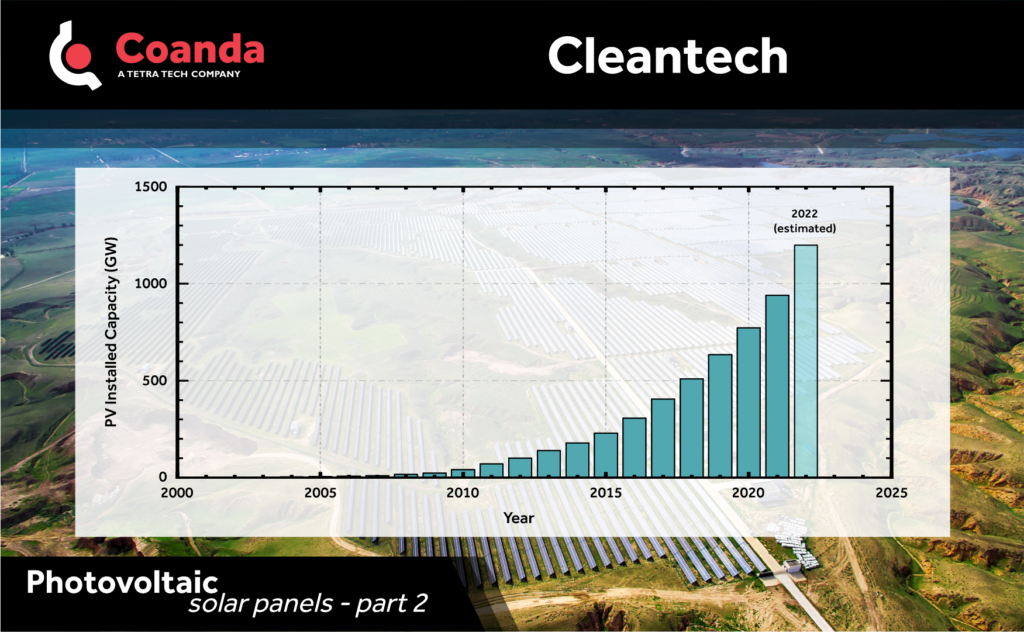Photovoltaic Solar Panels
Posted on February 9, 2023 Cleantech
This post was originally published in two parts which have been combined below.
Part 1 – Harnessing the Power of the Sun
The sun is the energy source for all life on Earth. It provides heat to the planet’s surface, oceans, and atmosphere. It nourishes the plants that other organisms rely on for food. And sunlight from long ago once sustained the life that has now become our so-called fossil fuels. However, solar energy can also be used as a clean resource to produce electricity, either directly or indirectly. In today’s post, we will be examining the most abundant type of solar energy—photovoltaic—and discuss its advantages, and the main challenges preventing its more widespread use.
Photovoltaic cells convert solar radiation directly into electric current (DC) via the photovoltaic effect, first discovered by the French scientist Edmond Becquerel. In 1839, Becquerel found that an electric current was produced when platinum electrodes coated with silver halides were exposed to light. With the development of semiconductor technology in the early 20th century, it became feasible to construct an array of photovoltaic cells into a panel capable of producing useful power. The first practical use of solar panels was to power the electrical systems of the Vanguard satellite, launched in 1958. Though conversion efficiency was poor and cost relatively high, by the 1970s, solar panels were being used in low power consumer electronics, such as calculators and digital watches. Since then, technological improvements in materials and manufacturing have taken place, such that the adjusted cost per unit power has decreased by a factor of more than 250, from $76/W to $0.30/W. This has resulted in the practical implementation of home energy systems in many areas, as well as the emergence of utility-scale photovoltaic power systems.
In our next post we’ll explore some of the challenges with the implementation of solar power.
Part 2

As with many other renewable resources, one disadvantage of solar power is variability of supply. Demand for electricity generally peaks at times when solar production is lowest, such as during evenings, when the weather is cloudy, and during winter months. While battery energy storage systems (BESS) can compensate for short term variations, these add to the installed cost, and seasonal variations must be balanced by using other resources.
Additionally, while operation of photovoltaic panels is virtually carbon-free, their production is not. It is estimated that the (fossil fuel) energy needed to extract the materials and manufacture a PV panel is equivalent to two years’ worth of its operation. Furthermore, the manufactured cells contain toxic chemicals which must be properly recycled to avoid other harm to the environment. Nonetheless, the emissions from PV electricity production, including manufacture, are up to 25 times less than those from producing an equivalent amount of power by burning coal.
Finally, there is the issue of land use. Because solar irradiance is finite (200-250 W/m2
at low latitudes), and photovoltaic efficiency is typically 20-25% for commercially available cells, it currently requires approximately two hectares of land near the equator to produce 1 MW of power. While technological improvements can help, the maximum possible output with 100% efficiency is about 2-2.5 MW per hectare. Still, it can be argued that this compares favourably with projects such as the Three Gorges Dam, which produces 22,500 MW of electric power from a reservoir that flooded 1,000 km2 of land (0.225 MW/ha).
Despite its drawbacks, worldwide photovoltaic installed capacity is growing at an astonishing rate. In 2021, production capacity was at 940 GW, with a further 260 GW projected to be completed by the end of 2022. This represents 8.5% of total production capacity and a 10-fold increase in just the past decade. If current growth is sustained, PV is set to surpass hydroelectricity as the leading sustainable source of electricity in terms of capacity as early as 2024.


